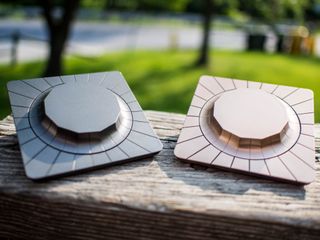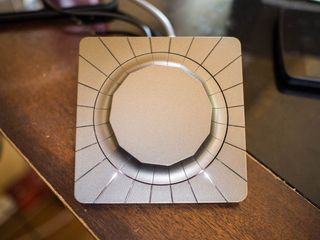Review: Making every speaker smarter with Beep

Exactly 16 months from the day I heard about a new company being formed with a pair of ex-Googlers to tackle the challenges associated with connecting all of the speakers in your home and granting them access to all of the great music services we have on our phones, the folks behind Beep put their finished hardware on my desk. Connected speakers are everywhere nowadays, but the core idea that sets Beep apart from the crowd — mainly that there needs to be a physical component to connected audio controls — is still a big deal. Unfortunately, the things that will move this product from being a cool idea with a fantastic design to something everyone should have in their homes and offices aren't yet available.
Here's our review.
Well-designed hardware

The first thing you notice about Beep is its design. Where most connected speaker tech tend to exist in glossy white or black, Beep stands out in either a series of metallic coatings or a transparent plastic limited edition. The wedge shape is designed to work on a speaker, on a table edge, or if you use the hook mounts on the back on a wall. Around the base of the dial there are LEDs in each notch, creating a ring around the device when its powered. It's also small enough to fit in the palm of your hand, but weighted just enough to keep it from sliding around anywhere. The hardware looks like it belongs next to high end stereo equipment, which is a bigger deal than you might think.

What makes Beep special is the ability to democratize all of the audio devices in your home, and give each device the same level of control over the environment. Whether you're rocking a proper home stereo system with optical inputs, a smaller bedroom setup with RCA jacks, or a little outdoor speaker with a 3.5mm port, you can connect a Beep to your system. With multiple Beep devices, you can connect all of these audio devices together and play music across each of them. By itself, this is not a new trick, but since the design for Beep includes a large dial with a center button that is used to help control the audio for individual devices, some additional functionality comes into play.
The Beep dial can be used to control the volume for the system it is connected to, but it can also be used to pause and skip tracks from whatever audio source you're playing from. There's a pleasing light animation for both volume control and playback around the dial, completing a generally friendly interface. The best part of this experience is the way playback happens both independent of and intertwined within the app you are streaming audio from. Once you start a an audio stream from your phone, you could completely power off your device and the stream remains unaffected, including the ability to skip tracks and pause. The pause function can last for days, too, so you can maintain the same Pandora or Spotify stream on your Beep without needing to pull your phone out for anything. When you do, however, your phone can control everything, including the volume on your Beeps.





Unfinished software
Be an expert in 5 minutes
Get the latest news from Android Central, your trusted companion in the world of Android
Simplicty is what makes Beep worth it from a software perspective. The setup process is exactly as easy as it should be, and if you run into problems with setup on your Wifi network the platform fails gracefully, instead of continuously trying to connect to something that isn't supported like we've seen competing products do. The Wifi chip in this device only works with 2.4 GHz networks and doesn't currently support unicode SSIDs, which was a problem for my 5 GHz primary network with (╯°□°)╯︵ ┻━┻ as an SSID, but it still took half the time to set Beep up on my guest network than it did to setup my Phorus Wifi speakers. In both hardware and software Beep has nailed the user interface, and they have done so in a way that their competition isn't likely to match anytime soon.
Beep doesn't feel like a finished product yet.
The only thing missing from Beep is almost everything most of us care about after setup. Currently there's only support for Pandora and Spotify, with SoundCloud and TuneIn support currently in Beta. You'll also find a Web Radio function with support for SomaFM, NPR, and a couple of others sprinkled in, but that's it for right now. Google Play Music All Access support isn't expected anytime soon, and Google has told Beep their hardware doesn't currently meet the spec required to support Cast for Audio. Beep has to add support individually and manually, at least until the company releases an API for third party apps to support the platform. When I asked the folks at Beep when the API was expected to launch, I was told the current focus is to improve stability and focus on the best possible experience for the larger services they support, but there are plans to eventually launch that API.

Local audio playback is also not supported, at least not officially or natively within the app. To play music stored on your device you have to create a DLNA server through a service like BubbleUPnP or AllCast, and the experience isn't nearly as good as the streaming capabilities within the Beep app. It's kind of a hacky workaround at the moment, and is absolutely something Beep needs to handle natively if they expect folks with local music collections to ever care about this hardware.
While the hardware is frankly some of the best I've used for this kind of connectivity, Beep doesn't feel like a finished product yet. Which is a shame, because at $150 Beep is less than half the cost of a Sonos Connect and works way, way better than a $180 Phorus PR5 receiver. If you use Spotify or Pandora exclusively for your music consumption, Beep is perfect for you. Everyone else in the music world is better off waiting for this product to spend a little more time in the oven.
